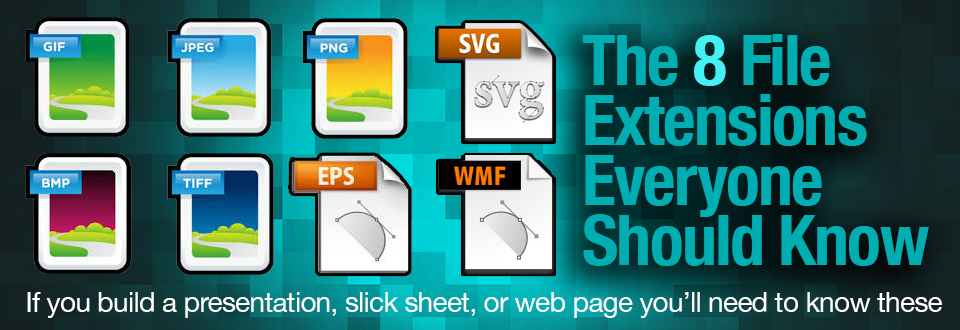There’s .eps, .jpg, .gif… m-o-u-s-e!
They are nonsensical, funny acronyms these abstract groupings of letters, but these file types have become, over time, the go-to files for just about every visual component of our lives. If you do any digital work you’ll need to know the how’s, what’s, and why’s to using them.
In my career I’ve had to change the way I produce pieces three times. The first way was to do it all by hand, from hand drawing logo types, ruling lines, to spec’ing and laying out type and then manually going from negative to plate to press. The second way was a hybrid version where you used hand work along with a computer to do some of those things but still went to plate by camera and then to press. The last way being what we all deal with now, the whole thing is on a computer and never go to print.
You might still go to print but it’s all computer and it’s direct to print as in no mechanicals, no negatives, no plate, no liquid ink.
Once computers integrated themselves with the entire process a whole new list of files came along that were added into the nomenclature to help aid the production process. One other reason these files became popular was due to how we transferred them. In the early days,paste-up boards were delivered by courier, hybrid files were transferred via phone lines, the totally digital process was transferred via cable and fiber. File density and speed were a big issue in the hybrid days so saving files in compressed form or using low density vector graphics helped speed the transfer process along. We still use those files but we are no longer using them to mitigate transfer issues like they once were.
Files like .jpg, .gif, .tif, .eps… these files all have specific uses and should be employed correctly to get the maximum results. There is a reason why you use one file over another and in certain cases these file types have definite benefits but not everyone knows what they mean and why. With the advent of hi-def digital cameras and their integration into cell phones, people are sharing photos left and right but very few of you know why you use a .jpg file format over a .tif let alone even know what those two acronyms mean.
Here is a list of 8 of the most commonly used files types, their meaning, their history, and when they should be used.
 The Bitmap file is the grandaddy of all pixel based image files hence the reason most designers use the name to refer to any pixel based image file. Use BMP for any type of bitmap (pixel-based) images. BMPs are huge files, but there is no loss in quality. BMP has no real benefits over TIFF, except you can use it for Windows wallpaper.
The Bitmap file is the grandaddy of all pixel based image files hence the reason most designers use the name to refer to any pixel based image file. Use BMP for any type of bitmap (pixel-based) images. BMPs are huge files, but there is no loss in quality. BMP has no real benefits over TIFF, except you can use it for Windows wallpaper.
 TIFF files are produced as a default by most scanners and are sometimes referred to as a RAW file. TIF produces large files, but there is no loss in quality. TIFF also preserves layers, alpha transparency, and other special features when saved from Photoshop or other photo editing packages. The main benefit to a TIF file is that it all of the information about the original image is in the file.
TIFF files are produced as a default by most scanners and are sometimes referred to as a RAW file. TIF produces large files, but there is no loss in quality. TIFF also preserves layers, alpha transparency, and other special features when saved from Photoshop or other photo editing packages. The main benefit to a TIF file is that it all of the information about the original image is in the file.
 Developed by CompuServe, the precursor to AOL, GIF is the file that set the standard for image use on the web. GIFs are great for Web graphics with limited colors. GIFs always reduced to 256 colors or less and they make very small, fast-loading graphics for the Web. They’re great for buttons, charts diagrams, cartoon-like drawing, banners, and text headings. GIF is also used for compact animations and should rarely be used for photos.
Developed by CompuServe, the precursor to AOL, GIF is the file that set the standard for image use on the web. GIFs are great for Web graphics with limited colors. GIFs always reduced to 256 colors or less and they make very small, fast-loading graphics for the Web. They’re great for buttons, charts diagrams, cartoon-like drawing, banners, and text headings. GIF is also used for compact animations and should rarely be used for photos.
 The first quality oriented file type for photos and illustrations it preserved much of the images quality. This file format is best for photos when you need to keep the file size small and don’t mind giving up some quality for a significant reduction in size. JPEG is not suitable for images with text, large blocks of color, or simple shapes, because crisp lines will blur and colors can shift.
The first quality oriented file type for photos and illustrations it preserved much of the images quality. This file format is best for photos when you need to keep the file size small and don’t mind giving up some quality for a significant reduction in size. JPEG is not suitable for images with text, large blocks of color, or simple shapes, because crisp lines will blur and colors can shift.
 Remember Photoshop clipping paths? I do and it was a pain to keep up with all the ways that Adobe changed that feature. But then along came PNG and it’s use of the Alpha channel and life was good again. Use PNG when you need smaller file sizes with no loss in quality and PNG files are usually smaller than TIFFs. PNG also supports alpha transparency and was developed to be a Web graphics replacement for GIF.
Remember Photoshop clipping paths? I do and it was a pain to keep up with all the ways that Adobe changed that feature. But then along came PNG and it’s use of the Alpha channel and life was good again. Use PNG when you need smaller file sizes with no loss in quality and PNG files are usually smaller than TIFFs. PNG also supports alpha transparency and was developed to be a Web graphics replacement for GIF.
 The old man of all scalable resolution independent files, this was the first professional quality image file for use in all print materials. Encapsulated Postscript Vector graphics (Adobe Illustrator) EPS is a file extension for a graphics file format used in vector-based images in Adobe Illustrator. EPS stands for Encapsulated PostScript. An EPS file can contain text as well as graphics. All you need to know, is that at any size this file is crisp and clean!
The old man of all scalable resolution independent files, this was the first professional quality image file for use in all print materials. Encapsulated Postscript Vector graphics (Adobe Illustrator) EPS is a file extension for a graphics file format used in vector-based images in Adobe Illustrator. EPS stands for Encapsulated PostScript. An EPS file can contain text as well as graphics. All you need to know, is that at any size this file is crisp and clean!
 One of the only vector files that PowerPoint would originally accept so if you wanted to be able to use smooth graphics in your presentation they needed to be exported out as a WMF. Windows Metafile is an image format originally designed for Microsoft in the ’90s. WMFs are portable between applications and may contain both vector graphics and bitmap components. It acts in a similar manner to SVG files.
One of the only vector files that PowerPoint would originally accept so if you wanted to be able to use smooth graphics in your presentation they needed to be exported out as a WMF. Windows Metafile is an image format originally designed for Microsoft in the ’90s. WMFs are portable between applications and may contain both vector graphics and bitmap components. It acts in a similar manner to SVG files.
If you’re building a presentation, a print piece, a web site, or a video you will use these file types.
The first 5 file types listed are pixel based (Pixel meaning picture or pix, element, hence pix-el) and they can be seen in a previewer and edited in those editors but there is a caveat for that. If they are compressed like GIF, JPG, or PNG they will begin to degrade with the different compressions being saved with each edit so be careful how you edit those picture files and how you ave them. The last 3 file types are vector files and typically cannot be previewed by double clicking on them. I can’t tell you how many times I get calls from folks after I’ve sent the file over asking why they can’t see the file when they click on it. That would be due to the fact that you need to place it in page to see it and you definitely can’t edit it, easily.
So these are the most popular, there are definitely more and they get more specific in their uses. But these are the ones that show up the most often and are used by us pretty much every day. Sometimes it’s nice to place meaning to an acronym.


